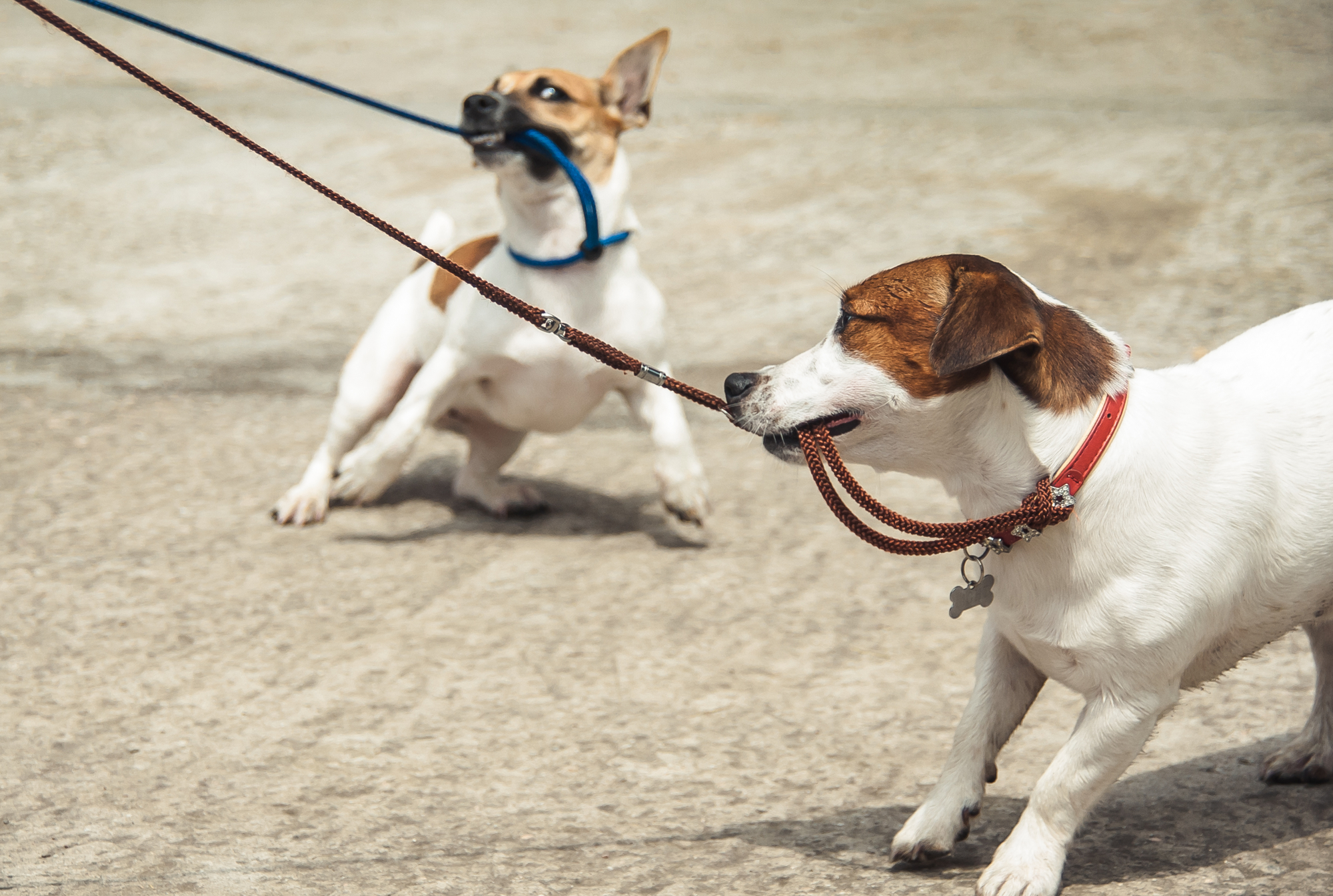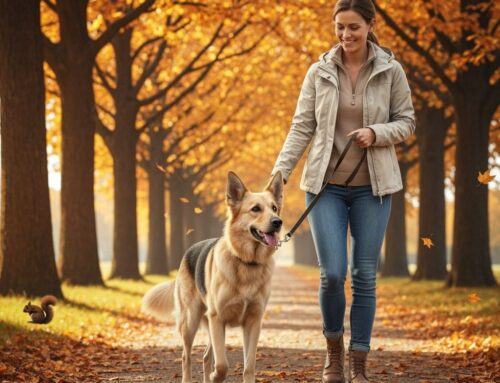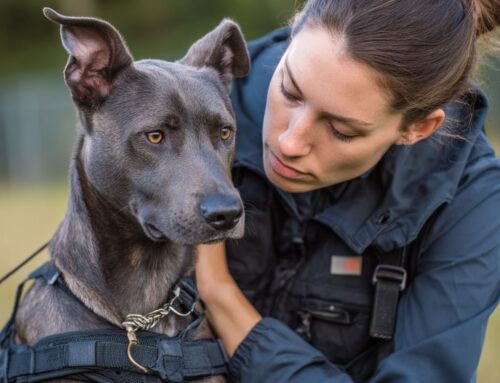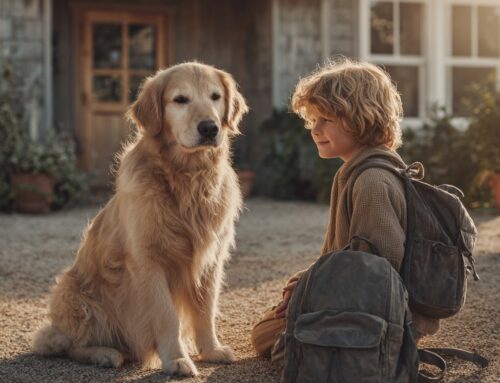It’s a picture-perfect day, and you’re off to what you hope will be a lovely stroll with your dog, but your hopes are quickly dashed. Even though your dog loves to play with other dogs during play dates and daycare, the minute you put that leash on and he sees another dog – your lovely stroll turns into a leash-based wrestling match between you and a dog that has suddenly turned savage in his behavior.
Leash Aggression
Is this my dog, you wonder? Your otherwise fun, delightful, and well-mannered dog? Your dog’s sudden behavior is called leash aggression, or leash reactivity. It is more common than you think and occurs when susceptible dogs are leashed and come across another dog. What happens is an otherwise docile and well-mannered dog turns into a lunging, growling animal, poised to attack.
Some of the common signs of leash aggression or reactivity include:
- Serious, vicious barking
- Howling
- Lunging and pulling strongly
- Biting if the other dog is close enough
Does this sound familiar? When you and your dog come across another dog and he launches into his aggressive mode, it is virtually impossible to regain his attention. In fact, the more you pull or try to otherwise distract your dog, you find that his behavior escalates. For any pet parent, leash aggression is a serious and upsetting affair that often results in a dog losing his walking privileges and being relegated to the backyard, or even worse, a sad situation for everyone involved.
What Are the Causes of Leash Aggression?
Innate as well as external things can trigger a dog and cause him to become leash reactive. The four primary and underlying causes of this behavior include:
- Pain reactivity
- Fear reactivity
- Frustration reactivity
- Dominant reactivity
Pain Reactivity
Simply put, something hurts. Pain is the first thing to look at, especially for dogs that have never been leash aggressive before. The root of this behavior is that the dog wants to keep other dogs away from him because he is in pain, and he thinks they may hurt him. If you have a reactive dog, this is the first thing to look at, especially if the reactivity has developed suddenly. As is true for any behavior changes, be sure to schedule a visit to your vet right away.
Fear Reactivity
If fear is at the root of a dog’s aggression, then most likely something in his past was traumatic enough to cause him to lash out at other dogs. Perhaps he had once been attacked by another dog, or pack of dogs, and now views all dogs as potential threats. His reaction is based on instinct as opposed to any rational thought process and his aggressive behavior is meant to keep all interlopers away.
Frustration Reactivity
A dog reacting due to frustration starts out wanting something and is thwarted in the process of trying to get it. Edgy by nature, a frustrated dog’s inability to get what he wants sets off a sequence of behaviors that end up not looking at all pretty. The more you try to pull the dog back, the more the episode escalates.
Dominance Reactivity
Dominant behavior is serious, especially since it can easily turn on you if not dealt with quickly and expertly. If a dog exhibits dominant behavior while on the leash, he may be guarding you or reacting to the posture and body language of an approaching dog.
How to Deal with Leash Aggression
Chances are that you’ve done everything you know how to do to learn how to change your dog’s aggressive behavior. It’s true that online articles and YouTube videos can help. However, the bad news is leash aggression can get worse over time. The good news is an expert trainer can help you mitigate your dog of this disturbing and potentially dangerous behavior.
The descriptions of leash aggression here skim the surface of the complexities that are involved, and when you are faced with the problem, you need in-depth assistance in solving it. This is where the experts can help.
David Greene who is the founder and training director of Performance K9 Training, says: “Many phone calls I get have to do with dog aggression. So many people are surprised to learn that a high percentage of my pet parents’ cases are geared towards dog aggression. Trust me, they are not alone.”
Getting Help
Greene is a true expert and top-notch trainer who has represented the USA on 4 world teams with his dogs. His approach in working with clients is to first meet with the dog and his family. This free-consultation meeting gives him insight into the issues with the family and dog. He first needs to know when and under what circumstances your dog first displayed the aggressive behavior as well as how you dealt with it. Then the goal becomes teaching the dog how to control his impulses as well as to understand that you, the pet parent, are there to protect and guide him.
The training program focuses on obedience in a distracting environment and is specifically designed for each dog. Using a “polished obedience” approach, your dog learns impulse control, which directs him away from the aggressive behaviors, despite any external distractions.
Performance K9 Training’s “board and train” is the program designed for dealing with these behaviors where the dog resides at the facility during the training. As the pet parent you will receive a progress report every few days on how your dog is progressing. Finally, when your pup has completed the program, you and he will get 10 private lessons to reinforce his skills and make sure you are comfortable and on board with the training regimen.
The goal of Performance K9 Training is to guide and teach you how to become the best possible pet parent while maintaining the training success your dog has achieved with us. When your dog has learned to obey you and control his impulses, you are on the road to living a stress-free and happy life together.
Call us now and find out how we can help!








